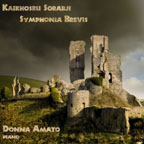Symphonia Brevis
Donna Amato (piano)
Altarus Records: AIR-CD-9064 (2011)
Web page for Altarus Records

Duration:
Track listing
- Track 1-7: Piano Symphony No. 5 Symphonia Brevis (114:27)
- Track 1: I - Movimento Libero. Intreccio ()
- Track 2: IIA - Adagio ()
- Track 3: IIB - Preludio Quasi Toccata ()
- Track 4: IIC - Aria Fiorita ()
- Track 5: IID - Interludio ()
- Track 6: IIE - Notturno ()
- Track 7: IIF - Nexus ()
Reviews
- “The extensive notes that accompany this release make a convincing case that it was in his cycle of enormous solo piano symphonies that Sorabji found the structure that allowed his extraordinary creative fecundity its most satisfactory means of expression. Certainly, on the strength of this, the penultimate, and shortest (at a bit more then 2 hours) of the series, it does appear that this unusual and ambitious form brought out the best in him. Even given its duration, and span of 7 (or, depending on how you count them, 9) movements, the piece seems startlingly compressed, yet it contains stellar examples of all Sorabji's most characteristic styles (apart from variations, which he reserved for the larger symphonies). Part 1 consists of the first movement, a teeming 35-minute bombardment of themes, ideas, motifs - presented and then immediately developed by combining them, or fragments of them, or transformed versions of them, while more material is simultaneously introduced and drawn into the argument. Every conceivable pianistic texture is thus conjured, from moments of static repose through 2-part invention to the shattering pylonic chords familiar from Opus clavicembalisticum. Part 2 begins with a trio of slow movements separated by two brief, highly virtuosic cadenza-like scherzi. A stately Adagio is separated from a very different, more linearly conceived and melodically gorgeous Aria by a bravura toccata; then a fast interlude acts as an introduction to a magnificent Nocturne in the highly decorated, texturally complex tradition of the composer's 'Gulistan'. Anyone who has found Sorabji's fugue writing hard to approach will likely warm to this work's comparatively modest specimen, a fully worked out Sorabjian fugue in miniature, on two short subjects, the first flexible and songlike, the second, waspish but humorous, irresistibly reminiscent of the composer's reading of his aphoristic 'sacrosanct modern superstitions - with comments!' for a BBC broadcast. The fugue is preceded by a furious, brittle introductory prelude, and after the expected mountainous climax of a coda-stretta, followed by a complete surprise, even a shock (and remaining so even when you know it's coming); a further movement, based on a pedal point. This epilogue builds inexorably to a resolution as unexpected, and cathartic, as anything in Sorabji's output - and then the work seems to evaporate, or recede into invisibility in a vast, bright distance, apparently having charted a lifetime of experience (as Ronald Stevenson said of his 'Passacaglia') in a few short minutes. Donna Amato premiered this work in London and New York, and has subsequently played it in Pittsburgh. Her expertise in performing Sorabji's music is well known, and amply documented in her many performances and recordings. She is the only pianist to date to have performed any of Sorabji's works for piano and orchestra (the 5th Piano Concerto, in the Netherlands, 2003), in addition to her many performances of his solo works. Her extensive discography of some 20 CDs covers a wide range of repertoire, also reflected in her concert appearances as soloist and chamber musician.” (Records International)
 Duration:
Duration:
